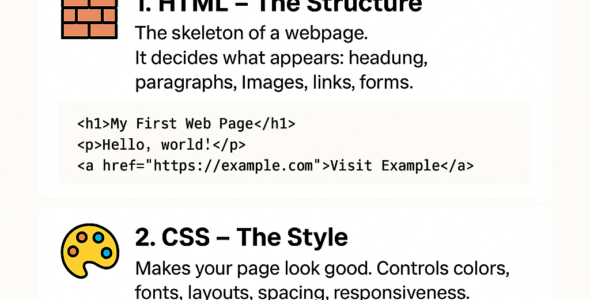In this module, we'll explore the CSS Flexible Box Layout Module, a powerful tool for creating flexible and responsive layouts. You'll learn about the syntax, examples, and best practices for using CSS Flexbox to craft complex and responsive layouts.
CSS Flexbox Basics
- Flex Container: The element that contains the flex items.
- Flex Items: The elements that are direct children of the flex container.
- Main Axis: The primary axis of the flex container, either horizontal or vertical.
- Cross Axis: The secondary axis of the flex container, perpendicular to the main axis.
CSS Flexbox Properties
- display: Defines the display type of the flex container.
Syntax: display: flex
Example: display: flex
- flex-direction: Defines the direction of the main axis.
Syntax: flex-direction: <direction>
Example: flex-direction: row
- flex-wrap: Defines whether flex items wrap to a new line.
Syntax: flex-wrap: <wrap>
Example: flex-wrap: wrap
- justify-content: Defines the alignment of flex items along the main axis.
Syntax: justify-content: <justify>
Example: justify-content: space-between
- align-items: Defines the alignment of flex items along the cross axis.
Syntax: align-items: <align>
Example: align-items: center
- flex-grow: Defines the growth factor of a flex item.
Syntax: flex-grow: <grow>
Example: flex-grow: 2
- flex-shrink: Defines the shrink factor of a flex item.
Syntax: flex-shrink: <shrink>
Example: flex-shrink: 1
- flex-basis: Defines the initial length of a flex item.
Syntax: flex-basis: <basis>
Example: flex-basis: 200px
Examples
- Create a simple flex layout with three items:
.flex {
display: flex;
flex-direction: row;
justify-content: space-between;
align-items: center;
}
- Create a flex layout with wrapping items:
.flex {
display: flex;
flex-wrap: wrap;
justify-content: space-between;
align-items: center;
}
- Create a flex layout with a fixed-width item:
.flex {
display: flex;
flex-direction: row;
justify-content: space-between;
align-items: center;
}
.item {
flex-basis: 200px;
}
Best Practices
- Use CSS Flexbox to create flexible and responsive layouts.
- Use display: flex to define the flex container.
- Use flex-direction to define the direction of the main axis.
- Use flex-wrap to define whether flex items wrap to a new line.
- Use justify-content and align-items to align flex items.
- Use flex-grow, flex-shrink, and flex-basis to control the size of flex items.
- Test your flex layouts in different browsers and devices to ensure compatibility.
By mastering CSS Flexbox, you'll be able to create complex and responsive layouts with ease.

